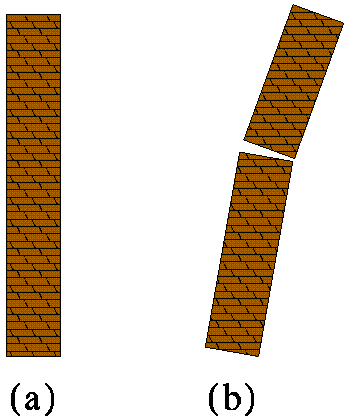Answer to the Question 07/96
The question was: A very tall chimney (width w, height h) starts
falling. At some point it will break as shown in the Fig.(b). When
will this happen and what will be the height of the breaking point?
A very tall chimney (width w, height h) starts
falling. At some point it will break as shown in the Fig.(b). When
will this happen and what will be the height of the breaking point?
(1/99) The problem has been solved correctly by Chethan Krishnan (e-mail ee95154@ee.iitm.ernet.in) from Indian Institute of Technology, Madras, India. Below we present his (slightly edited) solution.
The answer: The chimney will break at 1/3 of its height.
The solution:
If the angle made by the chimney while it is falling is A (at a particular instant) then the torque at the base will be
(1) . . . T1 = 0.5*m*g*L*cosA.
The moment of inertia of the chimney (relative to its base) is I1=m*L2/3. From the basic dynamical equation T1 = I1*a we get that angular acceleration
(2) . . . a = 1.5*g*cosA/L.
We see that the angular acceleration is inversely proportion to the length. The entire chimney is rotating with the same angular acceleration. Thus if we for instance look at only at some specific top part of the chimney, it will be rotating "slower than it should" under its own weight. It is "slowed down" because not only its weight is exercising a torque, but also the bottom part acts on it, and slows it down. That additional torque will eventually tear the chimney into parts.
The torque on a particular point on the rod - at a distance x from the top - caused by the weight of the top part will be
(3) . . . T2 = 0.5 *(m*x/L)*g*x*cosA=m*x2*a/3,
where we substituted the result of Eq.(2) into Eq.(3). This torque plus the torque T3 (which acts in the opposite direction) equal to the moment of inertia of the top part alone I2 multiplied by the same angular acceleration a.
(4) . . . I2*a = (m*x/L)*x2*a/3.
From Eqs.(2),(3), and (4), we get that
(5) . . . T3=T2-I2*a = m*x2*a/3-(m*x3/L)*a/3
This torque vanishes at the base and at the top of the chimney, and has a maximum at x=2L/3. Thus the chimney will break at a at height equal to 1/3 of its total height.
 Back to "front page"
Back to "front page"